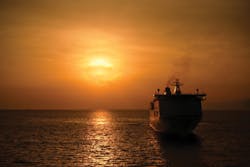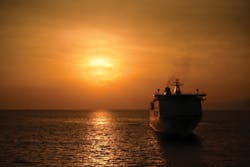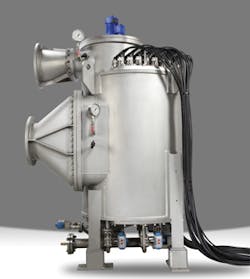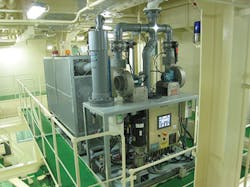Ballast Backlash: Is IMO Ratification Helping or Hindering Technology?
Ballast water treatment has increased in the past few years. US states such as New York and California have set their own requirements, with the stalled International Maritime Organisation Convention hovering in the background, waiting for ratification. How is this affecting manufacturers? WWi finds out.
Until now, ballast water exchange has been the normal way of counteracting the threat of invasive species, but new regulations will replace this with a requirement for treatment.
"The IMO Convention will in essence create a global requirement for most ships to install ballast water treatment," says Jim Cosman, ballast water treatment manager for Trojan Marinex. "There is a huge business opportunity in terms of supplying UV in this market, which is primarily regulatory driven."
There are two requirements for the Convention to be ratified - 30 countries must sign up, and 35% of the world's deadweight shipping tonnage (DWT). The country threshold has been exceeded - 35 countries are now signatories - but at 27.95% to date, the tonnage target has yet to be reached.
World trade expansion
As the recent MEPC 64 (The 64th session of the Marine Environment Protection Committee, which took place from 1 to 5 October) heard, around 6% of the world's merchant shipping gross tonnage is still needed to fulfill that requirement.
IMO Secretary-General Koji Sekimizu exhorted the audience: "I therefore, feel compelled, once again, to urge all countries that have not yet ratified the Convention and, in particular, major flag States to do so as soon as possible. The problems associated with ballast water are inherently connected to the expansion of the world trade so this is an issue from which the shipping industry cannot escape."
The delay is due to concerns among some critical countries such as Panama and the Bahamas (major flag carriers), about the possibility that even with an approved ballast water management (BWM) system on board, ship owners could still be penalized in the absence of a clear sampling methodology and unified procedures for port State control officers.
Another concern is slow implementation, due to lack of approved technologies, limited shipyard capacity, time availability and the costs involved, which these countries argue mean the application dates of the Convention may need to be reconsidered, Cosman explains.
The IMO notes that "there has been some discussion on availability of BWM technologies but many agree there are sufficient around". The organization adds that "there will be opportunity at MEPC 64 to discuss these issues again". There is a further meeting early next year, which will give a further chance for sufficient movement to bring the Convention into force.
MEPC 64 heard that Belgium, Argentina and Germany are close to ratification, but the IMO confirmed that these three countries would not provide the necessary gross tonnage.
Testing challenges
Ratification is only the first step. Cosman notes that "the primary issue is getting a representative sample of a ballast water tank - these are very, very large tanks that were never meant to be sampled. The second issue is what biological techniques are used to verify whether water does or does not meet the Convention. The limits look very much like wastewater standards, specifying the number of organisms in a volume of water."
He adds: "As a water treatment practitioner, the issue I see is that in North America we lay out standards in terms of E. coli, and what the wastewater treatment plant does is measure the amount of E. coli. The problem in a ballast water tank is that it could be any organism - coming up with techniques to determine their absence or presence is pretty easy, but whether they are live or dead is more difficult. It strikes me as very time-consuming, and it is still not standardized."
Cosman estimates that there are around 23 to 25 systems that have so far reached IMO type approval, which is the minimum requirement needed to sell equipment for marine use. However, whether this enables them to meet US type approval for ballast water treatment systems is another matter.
He adds: "The early assumption in the market was that as long as you had upfront approval there would be no problems - we have found this is not the case."
Cosman adds that the US type approval "is far more comprehensive, requiring far more assurance, quality control and testing, and must be done at US-accredited facilities". The process by which manufacturers obtain US approval has not yet been finalised he adds, meaning there is a degree of confusion in the market. Testing for type approval seems to be a key issue.
US Coast Guard view
Dr Richard Everett and John Morris of the US Coast Guard explain that the US discharge standards are basically the same as the IMO Convention. Morris says that "Coast Guard regulations are based on US law and are not dependent on the IMO Convention coming into force."
Regarding testing, he notes: "The Coast Guard and EPA developed test protocols under the Environmental Technology Verification (ETV) program, which are similar to the IMO Convention's G8 guidelines [which approve ballast water treatment systems] but have some differences that vendors seeking US type-approval must follow."
Some states - such as New York and California - already have their own standards, as Morris explains: "The authority of the Coast Guard and EPA allows states to set their own ballast water standards in state waters, so there is an ongoing discussion. We communicate with some states and government agencies, but we don't tell them what to do."
Dr Everett, who has been involved in developing both the USCG and IMO standards for the past ten years, adds: "Most pertinently, states are allowed to enact more stringent regulations than we might establish."
While some have gone down this route, he notes that "for the most part states as they have thought about how to implement these, have either backed away and dropped them or adjusted their policy so that it is clear that if they have a more stringent standard they won't be enforcing it."
On the other hand, if states want to set less stringent standards, the USCG regulations would override them. Dr Everett notes that in the US, there are two laws already in effect prior to the Convention that require the US to issue regulations for management of ballast water - the National Invasive Species Act and the Clean Water Act. The latter gives the US EPA authority to regulate ballast water discharges, which it does under its Vessel General Permit.
Organic relationships
The Invasive Species Act kick-started the Coast Guard programme, with the first regulations issued in 1993 and thereafter at regular intervals. "There is no organic relationship to the Convention and we didn't do it as a response," Dr Everett stresses.
"Our domestic requirements and need to manage ballast water preceded this, so when we were negotiating details of the Convention, many of the negotiating positions were based on the fact that we had already got some requirements in place and wanted to make sure the Convention reflected this. In general, the framework set up by the Convention is compatible with the Coast Guard regime."
Despite the delays in the Convention, ship owners need to start paying attention.
Mark Riggio, the product line manager for Hyde Marine, Calgon Carbon's medium-pressure UV and disc-filter based ballast water treatment system manufacturer, feels that regardless of the Convention and USCG grace periods (see box), people are unprepared for the reality.
"I don't think people have realised yet the full scope of what the USCG regulations mean, particularly owners." There has, he notes, been a "huge impending market for some time, but this is coming to a head".
Next year could be critical, with a realistic chance that the IMO Convention might be ratified - it would then come into force 12 months later. Nevertheless he warns: "There seems to be significant resistance to purchasing systems."
The EPA is even now developing a new permit to supersede the Vessel General Permit, he notes - adding a further layer of regulation owners must be aware of. "The text was recently published and includes terminology relating to ballast water treatment, not just exchange."
International implications
The stalled IMO Convention will implement quickly when it comes into force, he warns. The IMO requirement to have a system installed is based on the first dry dock survey after the Convention's implementation date, he explains, whereas the USCG requirement is for a deadline based on the first major survey.
Riggio explains: "In every survey there are two dry dockings. The IMO makes no distinction between the intermediate dry docking and a major dry docking. The Coast Guard stipulates a major survey. If a ship had just completed one of these it would have five years to comply. With the IMO it would have two and a half to three years, depending on when its next dry dock is due."
However, the US regulations are the only ones officially in place at the moment and these will affect a significant number of ships in the world as many visit the US. Ship owners need to start thinking about treatment systems now, he warns, in order to ensure they can get USCG type approval. "It will be a lengthy process. It will be between 12 and 24 months before any system receives US type approval," he warns.
Whatever route a ship owner may take - and sifting through the detail of what needs to be done will not be simple - it is clear that unless ships plan never to visit the US, they will require some sort of ballast water treatment system sooner rather than later.
"There are a number of competitors and a number of systems, so the pricing now should be very attractive relative to the future when more orders are being placed and supply, if not constrained, is at least tight," Riggio adds.
Call to arms
Severn Trent De Nora, which makes an electrolytic disinfection system for ballast water treatment, echoes the call for urgent action. A spokesperson says: "In reality, the US has the only existing ballast water treatment regulations. With the USCG Final Rule, which entered into force in June 2012, the stalled IMO Convention will only make the introduction of invasive species much worse and delay the inevitable.
"Continued delay to ratification of the Ballast Water Convention will only result in the appearance of flagrant disregard for good environmental stewardship - thus making the entire market suffer negative public opinion. Even the early adopters will be lumped together with the truly guilty and reputation recovery all the more difficult."
The spokesperson added: "Just waiting until there are no more choices and hoping the Convention goes away will eventually backfire on the industry. As the USCG and EPA rules eclipse the IMO Convention enforcement, the rest of the world will not be able to explain why such reasonable and effective actions were not taken when equipment to meet the standards was available."
Approval Regimes
IMO type approval is something all marine equipment must pass and is similar to other validation regimes. This scrutiny checks that the system is electrically safe and can withstand the harsh marine environment.
The US Alternate Management regime allows a system type approved from another country to be used while a treatment system is being reviewed for full US type approval. This would allow already installed systems to be used instead of undertaking ballast water exchange, the current practice that is being phased out.
The USCG STEP programme allows experimental equipment to be installed provided the owner gives data from the system to the Coast Guard. At the end of the five-year testing, providing the Coast Guard is happy, the system gets permanent approval
USCG type approval. This ultimate step will involve approval by an independent US laboratory (or laboratories) of ballast water management systems.
The IMO Convention and the USCG Rule
Under the IMO's International Convention for the Control and Management of Ships' Ballast Water and Sediments, parties undertake to give "full and complete" effect to the provisions of the Convention and the technical Annex in order to prevent, minimize and ultimately eliminate the transfer of harmful aquatic organisms and pathogens through the control and management of ships' ballast water and sediments (the ballast water performance standard).
Vessels built during or after 2009 have to install a type-approved ballast water treatment system immediately once the convention enters into force, and vessels built before 2009 must install a certified ballast water treatment system by 2014 or 2016 (depending on ballast water capacity of the vessel - vessels of between 1500 and 5000m3 must meet the 2014 deadline and ships smaller or larger than this have till 2016).
The USCG final Rule applies to two groups of vessels discharging ballast water into US waters - first, those vessels currently required to conduct exchange, and a second group, which was previously not required to exchange ballast water, consisting of seagoing vessels that do not operate beyond the US economic zone, take on and discharge ballast water in more than one Captain of the Port Zone, and are greater than 1600 gross register tons. The Rule took effect on 21 June 2012.
Ballast water exchange will continue to be required but is only a temporary option until the first drydocking after the applicable 2014 or 2016 date, after which a vessel is required to meet the discharge standard. The implementation schedule means that all new vessels built on or after 1 Dec 2013 must be compliant on delivery; existing vessels less than 1500m3 must comply by their first scheduled drydocking after 1 January 2016; existing vessels of between 1500m3 and 5000m3 must comply by their first scheduled drydocking after 1 January 2014, and existing vessels greater than 5000m3 must comply by their first scheduled drydocking after 1 January 2016.



